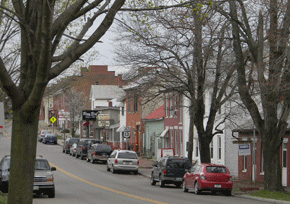SOMERSET AND ZANE'S TRACE
FLINT RIDGE, COSHOCTON
FLINT RIDGE, COSHOCTON
SOMERSET AND ZANE'S TRACE
From Flint Ridge, go south via Brownsville Road and SR 668 to Somerset. Of all the towns that developed along Zane’s Trace, tiny Somerset retains the feeling and the urban fabric of its origins as an early 19th century agricultural market town. While others like Zanesville, Lancaster and Chillicothe became more economically diversified, Somerset keeps the “Jeffersonian” ideal of an agrarian west, probably because it is situated on a high ridge far from river transportation or water power.
Settlers came here from the new United States and from Europe, especially German Rheinlanders after the Napoleonic wars. They were commercial agriculturalists, open to innovations and larger-scale operations, growing and selling crops to make money. At the turn of 1800, the fact that Ohio was “free country” also gave opportunities to poor American whites to become farm workers, which was not possible in the pre-Civil-War South because of slavery. The land was cheap, the soil was superb, people came pouring in along Zane’s Trace, and Somerset thrived.
Somerset probably contains more than thirty log structures, recognizable even through modern cladding because of their proportions and sometimes their subtle tilt. Somerset’s courthouse, on its “Pennsylvania” style town square, is one of only two surviving in the state from the once-common, first generation, pyramid-on-cube design. A second square, a couple of blocks west along the early highway and now called “Pigsfoot,” was for markets. South of town on SR 383, take the last right before the fence and pond to see the Catholic Priory of Saint Joseph, the oldest Roman Catholic church in the state.

Somerset’s Main Street, Clay Haus Restaurant in the middle on the right.